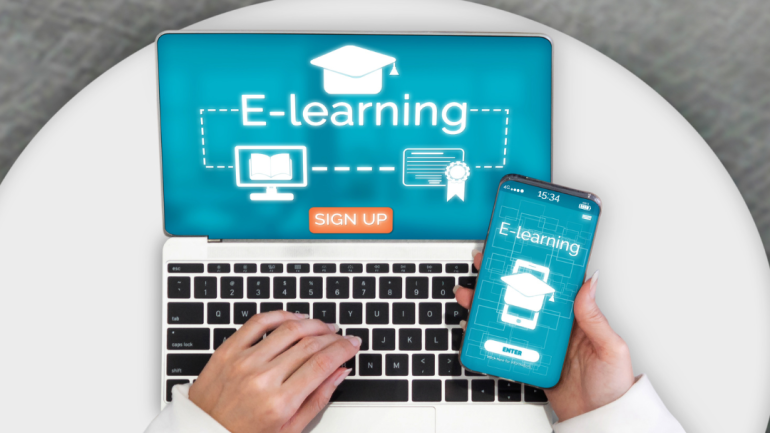Technology has had a huge impact on society and has changed how people learn. From the very beginning, when we used to learn through books, to now where we use smartphones, tablets, and computers to do our research before going down to the library. It seems like e-learning is one of the most significant changes in the education system, with online learning expanding exponentially.
Overview of the Impact and Role of E-learning
Technology is changing the way we learn and connect with the world faster than ever. This has really changed education, making it more accessible and affordable for everyone. Whether you’re trying to improve your communication and interpersonal skills for your job, want to get healthcare certifications, or just learn something new, online learning is a great option. It lets you access classes and learning materials from anywhere, on your own schedule.
There are several reasons why e-learning is such a powerful tool for teaching.
Provide Flexible Learning
First, it can be used to provide flexible and individualized access to learning materials for students of all ages and abilities. This means that no student is left behind or left feeling excluded from the learning process.
Affordable Tools
E-learning tools are often much more affordable than traditional methods of teaching. This makes them more accessible to students who may not be able to afford traditional school fees.
Work With Traditional Methods
E-learning tools can be used in conjunction with traditional methods of teaching to create a more comprehensive and effective educational experience for students.
How Does Technology Change Education?
Technology has had a drastic impact on education over the past few decades. From laptops in classrooms to VR technology in teaching, it continues to play a crucial role in how we learn.
One significant way technology has influenced education is through e-learning. E-learning is a learning format that utilizes electronic media, such as computers, the internet, and digital devices, to deliver instruction and achieve learning outcomes. In recent years, e-learning has gained increasing popularity due to its flexibility and convenience.
One key reason for the popularity of e-learning is its ability to enable students to access information from anywhere at any time. This flexibility is particularly beneficial for students with busy lifestyles or those unable to attend classes in person.
For instance, busy professionals seeking to enhance their skills for career growth can utilize platforms like the Corexcel Online Learning platform or others of similar caliber to support their continuous learning journey. This approach enables them to acquire new knowledge and skills at their own pace, seamlessly integrating education into their hectic schedules without the constraints of traditional classroom settings.
That being said, while e-learning has many benefits, there are also some drawbacks. For example, e-learning can be distracted by visual stimulation which can lead to information overload. Additionally, e-learning can be difficult to follow if the instructions are not clear. However, these drawbacks can be overcome with good instructional design and effective feedback mechanisms.
Overall, technology has had a significant impact on education over the past few decades.
The Tools for E-learning
To create an effective e-learning experience, it is important to have the right tools. Some of the most common tools for e-learning include:
E-Learning Platforms
Teachers and students can utilize an online learning platform or learning management system to post lectures, engage in class discussions, upload resources, and manage assignments, including grading. Furthermore, these platforms facilitate seamless communication between students and teachers, fostering collaboration and engagement in a virtual environment. Additionally, the integration of multimedia elements, such as videos, interactive simulations, and virtual reality, can enhance the learning experience, catering to various learning styles.
Course Management Systems
Course management systems (CMSs) are software applications that help instructors easily manage student enrollment, course materials, and grades. CMSs also provide tools for tracking and reporting student progress.
Webinars
Webinars are a popular way to deliver educational content. They allow participants to join live sessions from anywhere in the world. This makes webinars an ideal format for engaging students who are reluctant to attend class in person.
Virtual Reality
Virtual reality (VR) technology allows users to experience situations or environments that would be difficult or impossible to access in reality. VR technology has been used extensively in education to allow students to learn about various subjects, such as medicine and engineering.
Augmented Reality
Augmented reality (AR) is a type of VR where additional information is overlaid on real-world images. This information can include text, graphics, and videos. AR is often used to create customized educational experiences.
In short, technology has had a significant impact on education over the past few decades. From e-learning platforms to virtual reality and augmented reality, there is a tool available to help you create an effective learning experience.
Technology is playing a significant role in the education sector, with e-learning becoming an increasingly popular way to learn. This technology has made it possible for students to receive instruction from anywhere at any time, which means that they can continue their studies even when they’re not in the classroom. Additionally, online courses have become more affordable and accessible than ever before, making them a great option for people who are on a budget or who would like to take their education internationally.





